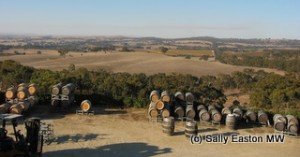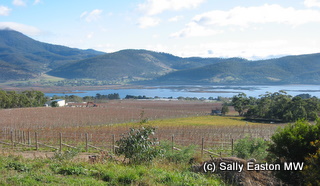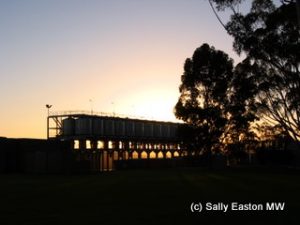Terroir in Australia – regionality by any other name?
A version of this article first appeared in the Drinks Business, May 2008.

Clare Valley, South Australia
After 200 years of viticulture are Australians beginning to find, or to want to find, a sense of place, an identification of terroir, in some of their wines?
The European model of terroir has evolved over centuries of experiential learning. Indeed that most famous of wine regions, of red wine regions, Bordeaux, was in a large part a white-wine growing region in the 16th century, when the Dutch wanted base material for eau-de-vie. Now it is 90% red, an evolution that began its turnaround in the 17th century, before Australia was even a twinkle in any European’s eye.
If terroir, or regionality, as the Aussies might call anything approaching it, has a recognisable taste-DNA in the glass, even the most hardened anti-terroirists would probably agree that wines such as Barossa shiraz, Hunter semillon, Clare riesling or Rutherglen muscat have a unique and identifiable flavour profile. These wines can’t really be from anywhere else. But what about Heathcote shiraz, Hunter shiraz, Hilltops shiraz? Is it just too early for the world to appreciate nuance and stylistic variety from Australia?
“Most of the wine drunk on a daily basis necessarily drops below the requirement for terroir” said Andrew Pirie, CEO and chief winemaker at Tamar Ridge Estates “because consumers are not looking at complexity or individuality of flavour but rather the basics of flavour, balance and freshness. Australia has been prodigious in this category.”
But, he adds “that is not to say that your average daily wine drinker would turn up his nose at complexity and individuality- it is just a fact that wines with terroir influence are rarely affordable for the mass consumer because large brands and large blends that occupy the terrain of the everyday drinker normally need by nature the steadiness of a large inter-regional blend to be repeatable.”
Directions to 2025
A key thrust of Directions to 2025, the latest strategy document for the Australian industry, is to increase this awareness that there is no one style and price of Australian wine.
And one of the strategy’s strands – ‘regional heroes’ – feeds neatly into the concept of terroir. Wines that focus on regional diversity, wines with ‘a clear association between region and variety and/or style’. This opens up opportunities for the Australian market to expand price points and add complexity to their offering by associating ‘region with style’ rather than grape variety with many styles, which, as Chile saw, can create a narrow perception of a country’s vinous offering.
‘Brand champions’ are still there as an integral core of the strategy which, at the high volume end of production, play to Australia’s original strength of inter-regional blending to produce sufficient volumes of consistently styled wine to meet any amount of demand.

Macedon Ranges, Victoria
This ‘sunshine in a bottle’ label has worked supremely well for two decades. But in an increasingly competitive global market, playing at the high volume end all the time makes one vulnerable to predation from other countries. Also, Mike Rogers of Aussie retail specialists Philglas and Swiggot said “I see what has made Australia really strong up to now — loads of fruit, low acidity, sweet tannin — is becoming less seductive to consumers. I think many people have got into drinking wine because Aussie wines are so accessible. But I think they’ve got more confidence to say they want something a little less obvious, less powerful, more quirky, more subtle, with more individuality and character rather than something that’s consistently good.”
Directions to 2025 details exactly this. The stated positioning challenge is to move from the ‘reliable, accessible, everyday’ to the high marking ‘super-premium, diverse, individual’.
And none of this is touchy-feely stuff. The stated aim is to deliver an additional AUD$4 billion of wine over the next five years, taking total turnover up to AUD$30bn by 2011. If only the French laid out some clear strategic marketing aims and put in place mechanisms for producers to plug into…
Paul Henry, general manager market development for the Australian Wine and Brandy Corporation has some experience straddling the new versus old world divide. He said: “the concept or philosophy of an Australian sense of terroir has never been absent, just much overlooked. Indeed, many of our now internationally recognised fine wines are ‘built’ along this European paradigm that place, rather then process, is all: ‘distinguished sites’ was a preferred phrase that still endures today.”
GI blues
Like appellations in Europe, the Geographical Indication system is one that delimits geographical boundaries according to agreed criteria. But the long contested boundary disputes of Coonawarra, in South Australia, and, more recently, King Valley in Victoria, illustrate that GI has little to do with terroir, or a consistent, single regional identity.

Tasmania
Brian Lynn, director of Majella Wines in Coonawarra, said: “we’ve always known the very best grapes from Coonawarra come from the terra rossa soils. The soil is very much the heart of the matter, so it behoves any consumer of Coonawarra wine to ask the provenance of any purchases – where were the grapes grown? Who made the wine etc.”
In Victoria, producers in the upland Whitlands plateau of the King Valley wanted their own GI, but to no avail, despite a decade of legal wranglings. At up to 900m above sea level, Whitlands is garnering its reputation for cool climate sparkling wine fruit, and aromatic varieties for still wine such as sauvignon blanc. They’ve argued that other areas of the King Valley are climatically distinct, allowing for example, the growth of fruit for fortified wines from much lower down the valley.
The Victorian microcosm
In the wider context Victoria looks hunky-dory to benefit from the regionality/terroir thing. With 21 different, diverse regions, the state of Victoria has some just claim to be Australia’s regional hero de force, and has adopted the “Wines from somewhere rather than wines from anywhere” strap-line.
The state’s wine industry association is busy preparing a marketing document telling the stories of each region, for example the Alpine Valleys promote ‘wine and food in cool mountain air’ with Mt Buffalo and Mt Feathertop providing rugged sporting opportunities such as paragliding, microlight flying, bush walking, trail riding and mountain biking. Après-ski Aussie-style perhaps?
As you’d expect, pinot noir dominates the Mornington Peninsula theme. Yarra Valley’s ‘love it all’ message sums up the sparkling base wine to fortified wine breadth of climatic diversity that exists in the valley. Trendy Heathcote focuses on shiraz and Cambrian soils.
The chief executive of the Victorian wine industry association, Joanne Butterworth-Gray said: “If we accept the definition that terroir is an aggregated effect of soil, topography, climate and possibly geology, then we have a fascinating story to tell – one that is unique within Australia.”
It would be a hard person indeed who disputed the unique attributes of Victoria’s Rutherglen muscats, but durif, brought to this small region exactly 100 years ago, is making a small name for itself. Colin Campbell, winemaker at Campbells in Rutherglen, said “While durif is grown in other parts of Australia, they’re different from ours. It’s more earthy and spicy than the newer clones that have come in over last 30 years.” It seems some of that old world experiential learning is rubbing off in double-quick time.
Henry’s earned the last word: “the latest marketing efforts of Wine Australia should be seen as seeking to introduce an additional level of detail in our category evolution – regionally distinct wine that has a credible and discernable sense of place. These aspects have always been here, they just haven’t always enjoyed an appropriate focus.” It’ll all help push up the average FOB price too.
Western Australia
Delimiting terroir
Terroir is oft-defined as a confluence of a myriad of factors in a specific geographical location, including climate, soil and vines. Within this, water relations, topography and man’s influence strongly feature.
For great terroir there have to be elements of taste-DNA in the glass that enable the taster to pin-point that greater or lesser geographical location.
Beyond the individual characteristics of grape varieties, some elements of place and climate are taken for granted: low versus high acidity; medium versus high alcohol; jammy, baked, stewed fruit versus crunchy, fresh, aromatic fruit. All these funnel into largely cooler or warmer climes.
Viticultural guru, Richard Smart said: “any place that grows wine has terroir, it goes without saying. Wine has a signature of the place where it was grown. But in the new world we talk about regional styles. Different regions have different attributes: Margaret River and Coonawara produce great cabernet sauvignon, the Barossa produces great shiraz, Tasmania sauvignon blanc, riesling and sparkling wine. Varietal suitability, the interaction of grape variety and climate it at the crux.”
“Those who have drunk wines from great terroir never doubt the superiority of a site over the creation of a wine blender” said Andrew Pirie, adding “the uncopy-able nature of terroir is what makes it unique, exciting and a step above wine which is just good. What is also attractive is that the character of wine created by terroir is irreproducible.”
In the words of Jeff Grosset, of Grosset Wines in Clare Valley: “The quality and purity of expression of variety is about the site and the making; eg the Grosset Springvale Watervale Riesling and the Grosset Polish Hill Riesling – both are considered of similar high quality, yet they are distinctly different. Given they are made in an almost identical fashion this difference is essentially due to site.”




